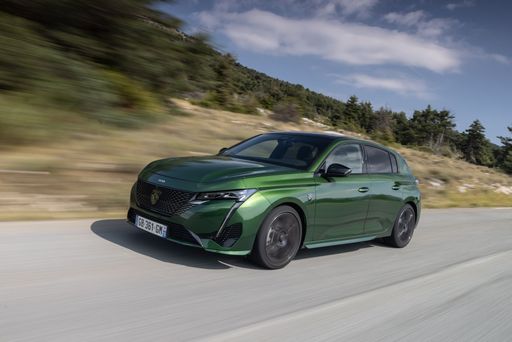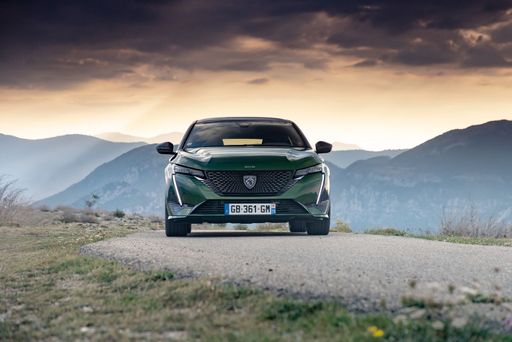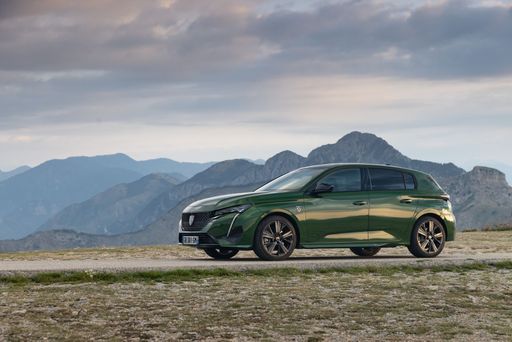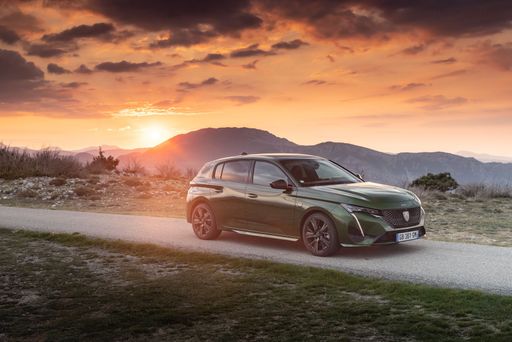Alfa Romeo Junior vs Peugeot 308 - Differences and prices compared
Costs and Efficiency:
Looking at overall running costs, both models reveal some interesting differences in everyday economy.
Alfa Romeo Junior has a slightly advantage in terms of price – it starts at 26100 £, while the Peugeot 308 costs 29200 £. That’s a price difference of around 3137 £.
Fuel consumption also shows a difference: Peugeot 308 manages with 2.30 L and is therefore clearly more efficient than the Alfa Romeo Junior with 4.80 L. The difference is about 2.50 L per 100 km.
In terms of energy consumption, the advantage goes to the Alfa Romeo Junior: with 15.10 kWh per 100 km, it’s barely noticeable more efficient than the Peugeot 308 with 15.60 kWh. That’s a difference of about 0.50 kWh.
As for range, the Peugeot 308 performs slight better – achieving up to 450 km, about 40 km more than the Alfa Romeo Junior.
Engine and Performance:
Power, torque and acceleration say a lot about how a car feels on the road. This is where you see which model delivers more driving dynamics.
When it comes to engine power, the Alfa Romeo Junior has a clearly perceptible edge – offering 280 HP compared to 195 HP. That’s roughly 85 HP more horsepower.
In acceleration from 0 to 100 km/h, the Alfa Romeo Junior is distinct quicker – completing the sprint in 5.90 s, while the Peugeot 308 takes 7.60 s. That’s about 1.70 s faster.
In terms of top speed, the Peugeot 308 performs hardly perceptible better – reaching 225 km/h, while the Alfa Romeo Junior tops out at 206 km/h. The difference is around 19 km/h.
There’s also a difference in torque: Alfa Romeo Junior pulls to a small extent stronger with 345 Nm compared to 300 Nm. That’s about 45 Nm difference.
Space and Everyday Use:
Whether family car or daily driver – which one offers more room, flexibility and comfort?
Seats: offers more seating capacity – vs .
In curb weight, Alfa Romeo Junior is slight lighter – 1380 kg compared to 1453 kg. The difference is around 73 kg.
In terms of boot space, the Alfa Romeo Junior offers slight more room – 415 L compared to 412 L. That’s a difference of about 3 L.
In maximum load capacity, the Peugeot 308 performs hardly perceptible better – up to 1323 L, which is about 43 L more than the Alfa Romeo Junior.
When it comes to payload, Peugeot 308 a bit takes the win – 503 kg compared to 420 kg. That’s a difference of about 83 kg.
Who comes out on top?
Overall, the Alfa Romeo Junior shows itself to be barely ahead and secures the title of DriveDuel Champion.
It convinces with the more balanced overall package and proves to be the more versatile choice for everyday use.
 @ Alfa Romeo / Stellantis Media
@ Alfa Romeo / Stellantis Media
Alfa Romeo Junior
Costs and Consumption
View detailed analysis
Engine and Performance
View detailed analysis
Dimensions and Body
View detailed analysis
Alfa Romeo Junior
The Alfa Romeo Junior captures the essence of Italian design with its sleek lines and compact dimensions, making it an icon of elegance and performance. With a spirited driving experience and a charming retro aesthetic, it appeals to enthusiasts and casual drivers alike. This delightful car embodies the brand's rich heritage while remaining a fun and engaging option for those seeking a unique automotive experience.
details @ Alfa Romeo / Stellantis Media
@ Alfa Romeo / Stellantis Media
 @ Alfa Romeo / Stellantis Media
@ Alfa Romeo / Stellantis Media
 @ Alfa Romeo / Stellantis Media
@ Alfa Romeo / Stellantis Media
Peugeot 308
The Peugeot 308 brings a sleek, feline profile and an unexpectedly upscale cabin, with clever packaging and materials that feel a touch more premium than you might expect. It’s composed on the road, easy to live with for daily life, and a smart choice if you want a stylish hatch that still behaves when the road gets interesting.
details @ Peugeot / Stellantis Media
@ Peugeot / Stellantis Media
 @ Peugeot / Stellantis Media
@ Peugeot / Stellantis Media
 @ Peugeot / Stellantis Media
@ Peugeot / Stellantis Media
 @ Peugeot / Stellantis Media
@ Peugeot / Stellantis Media
 @ Peugeot / Stellantis Media
@ Peugeot / Stellantis Media
 @ Peugeot / Stellantis Media
@ Peugeot / Stellantis Media
 @ Alfa Romeo / Stellantis Media
@ Alfa Romeo / Stellantis Media
|
 @ Peugeot / Stellantis Media
@ Peugeot / Stellantis Media
|
|
|
|
Costs and Consumption |
|
|---|---|
|
Price
26100 - 41600 £
|
Price
29200 - 42600 £
|
|
Consumption L/100km
4.8 - 5.4 L
|
Consumption L/100km
2.3 - 5 L
|
|
Consumption kWh/100km
15.1 - 17.5 kWh
|
Consumption kWh/100km
15.60 kWh
|
|
Electric Range
344 - 410 km
|
Electric Range
78 - 450 km
|
|
Battery Capacity
0.4 - 51 kWh
|
Battery Capacity
0.40 kWh
|
|
co2
0 - 119 g/km
|
co2
0 - 129 g/km
|
|
Fuel tank capacity
44 - 45 L
|
Fuel tank capacity
42 - 52 L
|
Dimensions and Body |
|
|---|---|
|
Body Type
SUV
|
Body Type
Hatchback
|
|
Seats
5
|
Seats
5
|
|
Doors
5
|
Doors
5
|
|
Curb weight
1380 - 1689 kg
|
Curb weight
1453 - 1749 kg
|
|
Trunk capacity
340 - 415 L
|
Trunk capacity
314 - 412 L
|
|
Length
4173 mm
|
Length
4367 mm
|
|
Width
1781 mm
|
Width
1852 mm
|
|
Height
1505 - 1538 mm
|
Height
1438 mm
|
|
Max trunk capacity
1205 - 1280 L
|
Max trunk capacity
1258 - 1323 L
|
|
Payload
390 - 420 kg
|
Payload
430 - 503 kg
|
Engine and Performance |
|
|---|---|
|
Engine Type
Electric, Petrol MHEV
|
Engine Type
Petrol MHEV, Diesel, Plugin Hybrid, Electric
|
|
Transmission
Automatic
|
Transmission
Automatic
|
|
Transmission Detail
Reduction Gearbox, Dual-Clutch Automatic
|
Transmission Detail
Dual-Clutch Automatic, Automatic Gearbox, Reduction Gearbox
|
|
Drive Type
Front-Wheel Drive, All-Wheel Drive
|
Drive Type
Front-Wheel Drive
|
|
Power HP
136 - 280 HP
|
Power HP
131 - 195 HP
|
|
Acceleration 0-100km/h
5.9 - 9.1 s
|
Acceleration 0-100km/h
7.6 - 10.6 s
|
|
Max Speed
150 - 206 km/h
|
Max Speed
170 - 225 km/h
|
|
Torque
230 - 345 Nm
|
Torque
230 - 300 Nm
|
|
Number of Cylinders
3
|
Number of Cylinders
3 - 4
|
|
Power kW
107 - 207 kW
|
Power kW
96 - 144 kW
|
|
Engine capacity
1199 cm3
|
Engine capacity
1199 - 1598 cm3
|
General |
|
|---|---|
|
Model Year
2024 - 2025
|
Model Year
2025
|
|
CO2 Efficiency Class
A, C, D
|
CO2 Efficiency Class
C, D, B, A
|
|
Brand
Alfa Romeo
|
Brand
Peugeot
|
What drive types are available for the Alfa Romeo Junior?
Available configurations include Front-Wheel Drive or All-Wheel Drive.
The prices and data displayed are estimates based on German list prices and may vary by country. This information is not legally binding.
